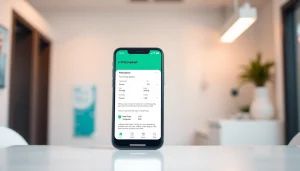Enhancing Practice Efficiency with Effective ePrescribing Software for Doctors

Understanding ePrescribing Software for Doctors
What is ePrescribing Software for Doctors?
In the rapidly evolving landscape of healthcare technology, eprescribing software for doctors serves as a pivotal tool for modern medical practices. At its core, ePrescribing software allows healthcare providers to electronically send prescriptions to pharmacies, replacing traditional handwritten prescriptions. This digital transformation not only streamlines the prescribing process but also enhances patient safety and reduces the risk of medication errors.
The software integrates with electronic health record (EHR) systems, enabling doctors to access patient records, medication histories, and formulary information seamlessly. This integration is crucial for ensuring that doctors have complete and up-to-date data at their fingertips, leading to more informed prescribing decisions.
Key Features of ePrescribing Software for Doctors
ePrescribing software offers a variety of features designed to improve efficiency and safety in prescribing. Common key features include:
- Medication History Access: Doctors can view patients’ past prescriptions to avoid potential drug interactions.
- Formulary Checks: These systems verify whether prescribed medications are covered by the patient’s insurance, reducing out-of-pocket costs.
- Refill Management: Automated reminders help manage prescription refills, ensuring patients never run out of essential medications.
- Real-Time Pharmacist Communication: Direct communication channels with pharmacists expedite clarifications and corrections, enhancing patient care.
- Controlled Substance Management: Built-in compliance features help manage prescribing of controlled substances to ensure legal and safe practices.
- Patient-Specific Recommendations: Some advanced systems use algorithmic suggestions to recommend medications based on individual patient profiles and evidence-based guidelines.
Benefits of Implementing ePrescribing Software for Doctors
The implementation of ePrescribing software in medical practices brings numerous benefits not only for doctors but also for patients and pharmacies:
- Improved Accuracy: Reduces the likelihood of errors associated with handwriting prescriptions, which can lead to incorrect dosages or medication names being misread.
- Enhanced Efficiency: Saves time spent on paperwork, allowing healthcare providers to focus more on patient care.
- Increased Patient Safety: Alerts for potential drug-drug interactions and allergies prompt safer prescribing processes.
- Streamlined Workflow: Integration with EHR systems offers a unified workflow, making it easier for staff to manage administrative tasks.
- Better Patient Engagement: Patients receive their medications faster without the need for physically dropping off a prescription.
Choosing the Right ePrescribing Software for Doctors
Factors to Consider When Selecting ePrescribing Software for Doctors
When choosing ePrescribing software, several factors should be taken into account to ensure that the selected solution meets the specific needs of the medical practice:
- Integration Capabilities: Ensure the software integrates smoothly with existing EHR systems to minimize disruptions in workflows.
- Compliance with Regulations: The software should comply with relevant legal standards, including HIPAA and state regulations about electronic prescriptions.
- User-Friendliness: An intuitive interface is essential for minimizing training time and increasing adoption rates among staff.
- Customer Support: Reliable customer support is crucial for resolving issues swiftly without impacting patient care.
- Cost-Effectiveness: Consider not only the initial costs but also ongoing expenses and the potential for long-term savings through increased efficiency.
Comparing Top ePrescribing Software for Doctors
To make an informed decision, practices should conduct a thorough comparison of available ePrescribing software options. Key comparison points include:
- Feature Sets: Assess which features are essential for your practice and how each software provider addresses those needs.
- User Feedback: Look for reviews and testimonials from other practitioners who have used the software.
- Demo Versions: Taking advantage of demo versions or free trials can provide insights into the software’s usability and functionality.
- Customization Options: Determine whether the software allows for customization to fit the specific workflows of your practice.
User Reviews and Ratings of ePrescribing Software for Doctors
Monitoring user reviews and ratings can provide a deeper understanding of the software’s strengths and weaknesses. Platforms that aggregate reviews can offer insights into:
- Satisfaction Levels: Positive ratings often indicate reliable performance and satisfied users.
- Common Issues: Learn what challenges users typically face and how the software provider responds to these concerns.
- Comparison Metrics: Utilize user-generated content to compare various software options more effectively.
Integrating ePrescribing Software for Doctors into Your Practice
Steps for Successful Integration of ePrescribing Software for Doctors
Implementing ePrescribing software requires careful planning and execution. Key steps include:
- Preparation: Assess the current workflow and how it will change with the introduction of ePrescribing.
- Data Migration: Carefully plan and execute the transfer of existing patient data into the new system.
- Stakeholder Engagement: Involve all relevant stakeholders, including doctors, nurses, and administrative staff, in the integration process.
- Testing: Conduct tests to ensure that the system is functioning correctly before going live.
- Feedback Loop: Create a system for collecting feedback during the initial rollout to identify and address any issues that arise.
Training Staff on ePrescribing Software for Doctors
Effective staff training is crucial for the successful adoption of ePrescribing software. Consider the following strategies:
- Comprehensive Training Modules: Develop training sessions that cover all aspects of the software, tailored for different user roles.
- Hands-On Practice: Allow staff to practice using the software in a controlled environment before they switch to live patient cases.
- Continuous Learning: Implement ongoing training opportunities as software updates are released or new features are added.
- Support Resources: Provide reference guides, FAQs, and support contacts to help staff troubleshoot on their own.
Common Challenges and Solutions When Using ePrescribing Software for Doctors
While ePrescribing software offers numerous benefits, challenges can arise during its use. Addressing these proactively can lead to smoother operations:
- Technical Glitches: Prepare for potential technical issues by ensuring robust IT support is available and regularly updating the software to the latest versions.
- Resistance to Change: To address reluctance among staff, emphasize the benefits of the software for improving patient care and operational efficiency.
- Data Privacy Concerns: Promote a culture of data security and ensure that staff receive training on best practices for protecting patient information.
- Interoperability Issues: Verify that the ePrescribing software can communicate effectively with other health IT systems to ensure a seamless workflow.
Optimizing Usage of ePrescribing Software for Doctors
Best Practices for Using ePrescribing Software for Doctors
To maximize the effectiveness of ePrescribing software, practitioners should adopt certain best practices:
- Regularly Review Prescribing Patterns: Analyzing prescribing behaviors can provide insights that improve clinical outcomes.
- Encourage Patient Engagement: Share information with patients through patient portals or similar tools to help them stay informed about their medications.
- Monitor Compliance: Stay up-to-date with the latest regulations governing ePrescribing to ensure compliance and maintain best practices.
- Utilize Reporting Features: Take advantage of built-in analytics to evaluate the impacts of the software and identify areas for improvement.
Staying Compliant with Regulations in ePrescribing Software for Doctors
Understanding and adhering to regulations surrounding ePrescribing is essential for all medical practices. Key compliance measures include:
- HIPAA Compliance: Ensure that all patient data is handled according to HIPAA regulations for the protection of personal health information.
- State Laws: Familiarize yourself with varying state laws regarding electronic prescriptions, especially for controlled substances.
- Audit Trails: Keep accurate records of all prescribing activities to maintain an audit trail that can be reviewed if needed.
- Data Encryption: Implement advanced security measures, such as end-to-end encryption, to safeguard sensitive information.
Collecting and Analyzing Data from ePrescribing Software for Doctors
Data collection and analysis are vital for continuous improvement. Practices should consider the following:
- Track Prescribing Trends: Monitoring changes in prescribing habits can reveal important patterns for drug utilization.
- Patient Outcomes Monitoring: Study the effectiveness of prescribed medications by collecting patient feedback and outcomes data.
- Integrate with Analytics Tools: Use advanced analytics tools to make data-driven decisions that enhance patient care.
- Benchmark Against Standards: Compare your findings against industry benchmarks to identify strengths and opportunities for improvement.
The Future of ePrescribing Software for Doctors
Emerging Trends in ePrescribing Software for Doctors
The landscape of ePrescribing is constantly evolving. Some emerging trends include:
- Increased Mobile Accessibility: Mobile applications for ePrescribing are on the rise, allowing doctors to prescribe medications quickly and efficiently from anywhere.
- Blockchain Technology: The adoption of blockchain can enhance data security and integrity, ensuring secure transactions and patient privacy.
- Enhanced Patient Engagement Tools: New features that promote patient education and adherence are becoming a standard part of ePrescribing solutions.
- Telehealth Integration: As telehealth gains acceptance, ePrescribing will increasingly integrate with virtual care platforms.
How AI and Machine Learning are Shaping ePrescribing Software for Doctors
Artificial intelligence (AI) and machine learning (ML) are beginning to play a significant role in the future of ePrescribing:
- Predictive Analytics: AI can analyze patient histories and outcomes to recommend the most effective medications.
- Personalized Prescribing: Machine learning algorithms can tailor prescribing decisions to individual patient needs based on data.”
- Automated Alerts: AI can produce alerts for potential drug interactions or allergies, enhancing patient safety.
- Administrative Efficiency: Automating administrative tasks can free up healthcare providers to focus on patient care.
Predictions for the Evolution of ePrescribing Software for Doctors
As technology continues to advance, the future of ePrescribing software looks promising. Key predictions include:
- Universal Interoperability: Future systems are expected to be fully interoperable, allowing seamless sharing of prescription data across all platforms.
- Greater Focus on Patient Experience: Tools designed to enhance the patient experience will become integral to ePrescribing solutions.
- Regulatory Advancements: New regulations will likely evolve to enhance safety and efficacy surrounding ePrescribing practices.
- Integrating Health Data Beyond Prescriptions: Future systems may integrate broader health data sets to offer a more comprehensive view of patient health.







